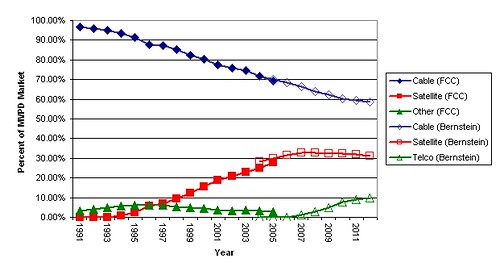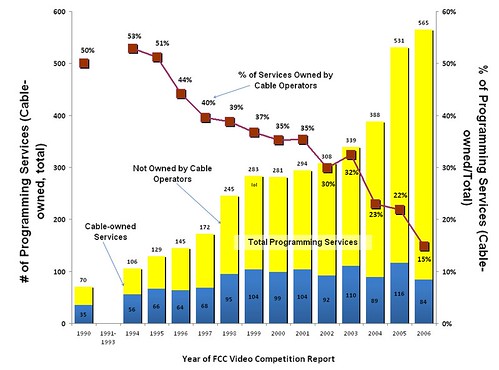Ken Ferree and I just filed an amicus brief with the D.C. Circuit in what could be among the most important First Amendment cases involving economic regulation in years: Comcast's challenge to the FCC's cap on the maximum size of a cable operator's nationwide subscriber-audience. While few may feel righteous indignation at limitations targeted at large corporations such as Comcast or Time Warner, the larger principle at stake here is deeply important: Will the First Amendment provide a meaningful check on what USC law professor Chris Yoo has called "architectural censorship" (i.e., so-called "structural" regulations that "have the unintended consequence of reducing the quantity, quality, and diversity of media content").
In a nutshell, we argue that that:
- The provisions of the 1992 Cable Act authorizing the FCC to impose a "cable cap" are outdated in world of media abundance and vibrant platform competition.
- Because cable is no longer the unique "bottleneck" or "gatekeeper" that it was in 1992, these statutory provisions (not just the FCC's 30% rule) must be subject to strict scrutiny under the First Amendment as a limitation on free speech.
- Because there are "less restrictive means" of ensuring cable operators do not impede the flow of video programming to consumers, the court should strike down these provisions.
- Even if the court upholds the statute, it should nonetheless strike down the cap issued by the FCC in December 2007 (30% of all Multichannel Video Programming (MVPD) subscribers as based on an outdated model of the video marketplace.
Strict Scrutiny. Yoo's article Architectural Censorship and the FCC is essential reading for anyone who believes that government regulations on the size and shape of the "soapbox" can have huge effects on speech itself. Yoo argues that the First Amendment should check this kind of regulation--however "content-neutral" it might seem--under "strict scrutiny", which requires that the government show that a regulation is the "least restrictive means" available for advancing a "compelling government interest." But Yoo ultimately concludes (pp. 713-718, PDF pp. 45-50) that, under existing precedent, most "architectural censorship will be effectively insulated from meaningful judicial review."
Yoo explains that the Supreme Court's 1983 decision in Minneapolis Star & Tribune Co. v. Minnesota Commissioner of Revenue, "appeared to entertain the possibility of subjecting structural restrictions to strict scrutiny even in the absence of facial content discrimination or content-based motive." But in its 1991 Leathers v. Medlock decision, the Court "foreclose[d] any prospect that Minneapolis Star and its progeny would serve as a check on architectural censorship" by limiting the Minneapolis Star line of precedents to cases where "a statute of general application affects a small number of speakers." The Court reaffirmed this position in its 1994 Turner I decision, when it applied intermediate, rather than strict, scrutiny to the Cable Act's "must-carry provisions," which require nearly all cable operators to carry certain television broadcast signals. Intermediate scrutiny requires only that important governmental interests that are furthered by "substantially related means."
Unfortunate as the Leathers/Turner I line of cases is for those concerned about architectural censorship, the cable cap is exactly the sort of regulation that falls within the reduced scope of Minneapolis Star as "affect[ing] a small number of speakers" because, unlike the Cable Act's must-carry provisions, the cap limits the speech of only the very largest cable operators. So the question of whether the Court should default to intermediate scrutiny as it did in its 2000 Time Warner I decision (when the cap was first challenged) should turn entirely on the question of whether cable still has the "special characteristic" of "bottleneck" or "gateekeeper" power despite all the changes in the media marketplace since 1992 and even in just the last eight years.
The Modern Media Marketplace. The subscriber limitation provisions of the Cable Act were intended to prevent cable operators from "unfairly impeding the flow of video programming." Yet each of the key premises behind these provisions has been disproven:
- Increased horizontal concentration of the cable industry has, far from reducing media choices, been accompanied by an explosive growth in the amount and diversity of video content available to consumers.
- The rate of "vertical integration" (i.e., ownership of cable programmers by cable operators), which Congress feared would cause cable operators to discriminate against unaffiliated programmers, has plummeted.
- Cable's share of the MVPD market has also plummeted dramatically, with the two DBS providers now sharing 1/3 of the MVPD market and representing the second and third largest MVPDs
Two charts say it all. First, from Adam Thierer's excellent book Media Metrics, the number of programming services (cable channels) has grown by nearly six-fold by 1992, while the rate of vertical integration has plummeted:
(That chart stops in 2006 (based on 2005 data) because the FCC still has not released the 2007 Video Competition Report, which it approved in December 2007. Since then, Time Warner Cable has been spun off of Time Warner's content empire, so the actual affiliation rate today is likely less than 10%.)
Second, cable's share of the MVPD market has fallen from 95% in 1992 to ~64% today:

In 1992, when consumers had only a single MVPD option, cable might fairly have been considered a "bottleneck" or "gatekeeper." But today, every American has at least three MVPD choices (their local cable franchisee + two DBS operators), and can also subscribe to a Telco video service such as Verizon's FiOS. ("Over-building" where two cable operators serve the same area is rare.)
Internet Video. We also describe how the availability of TV content online provides yet another distribution channel for programmers:
The last two years have seen growing numbers of Americans increasingly substituting consumption of online video for MVPD video and the Internet driving popularity of MVPD content, rather than vice versa. But only in the last year, since the adoption of the [FCC's December 2007 order issuing the 30% cap], has the large-scale delivery of television content online become a reality, as large numbers of programmers have begun distributing increasing numbers of complete episodes and entire series through their own websites and/or through a new class of rapidly-growing Internet Video Programming Distributor (IVPD) websites such as Netflix, Hulu, Amazon Video on Demand, iTunes, Vuze, Sony Playstation Store, the Microsoft Xbox 360 Marketplace, Joost and Veoh. These IVPDs already offer a staggering, and growing, library of currently-airing and archived content--as much as 90% of broadcast shows and 20% of cable shows. These sites are supported by a growing number of set-top devices (e.g., Netflix Player by Roku, TiVo) and wildly popular game consoles (e.g., Microsoft Xbox 360, Sony PlayStation 3) that allow users to play IVPD content from broadcast and cable programmers on demand on their television, while TiVo allows users to seamlessly switch between IVPD, MVPD and OTA content.
The FCC's decision to exclude Internet video from its analysis is hardly surprising when one considers that the economic model behind the new 30% cap comes from a 2005 study based on cable market data from 1984-2001 and that the last official data released by the agency about the video marketplace date to June 2005. But nine months later, the agency waxed ecstatic about the promise of IVPDs when doing so supported Kevin Martin's attempts to enforce the FCC's non-binding 2005 "Net Neutrality" policy statement:
In August 2008, the FCC even cited [the rapid emergence of IVPDs] in support of its claim of jurisdiction over Comcast's broadband network management practices (because of alleged harm to an IVPD that distributes content through peer-to-peer file sharing): "consumers with [broadband] service will have available a source of video programming (much of it free) that could rapidly become an alternative to cable television." But the immediate competitive impact of IVPDs comes not from the fact that some IVPD users are already canceling their MVPD subscriptions, but in the ease with which IVPDs can supplement an MVPD subscription--because most IVPDs are free, while those that charge for content do so on a per-episode/show basis. Furthermore, IVPDs have little--if any--incentive not to offer a particular program because they are not subject to the same capacity constraints as MVPDs. Thus, even if IVPD video consumption remains relatively small in its early years, IVPDs already offer programmers a strong alternative distribution channel capable of reaching all broadband users.
Less Restrictive Means. Of course, the fact that cable no longer has a special characteristic of gateekeeper or bottleneck power does not automatically render the Cable Act's subscriber limits provisions unconstitutional; this merely means that the government must show that no less restrictive means are available to satisfy a compelling government interest. We suggest a variety less restrictive means that could ensure competitive video distribution and programming markets. These include dispute resolution assisted by the FCC, enforcement of existing antitrust laws, and crafting "special obligations on cable operators with more than 30% of the MVPD market to ensure that they do not unfairly impede the flow of video programming."
Challenging The FCC's Rule. Besides attacking the statute, we argue that the 30% cap imposed by the FCC last year is even more obviously unconstitutional than when the D.C. Circuit struck down the same limit seven years ago in Time Warner II. To many lay observers, this argument may seem like a "no-brainer" given how much more competitive the video marketplace is than it was in 2001. But one must understand that when the Court struck down the 30% cap the first time, it did so on the grounds that the FCC's own rationale justified not a 30% cap but a 60% cap. The FCC had decided that the average video programmer (network) needed an "open field" of 40% of the MVPD market to be viable. The FCC leapt from that conclusion to a 30% cap so that even if the two largest cable companies denied carriage, the programmer would still have the required 40% "open field." The court found that there was no evidence that the leading two cable operators would collude to deny carriage and that the statute did not "protect programmers against the risk of completely independent rejections by two or more companies." In other words, the purpose of the statute was not to guarantee carriage even if, for example, a cable operator decided (exercising the same constitutionally-protected "editorial discretion" enjoyed by all media) spend part of its limited system capacity carrying a network with questionable appeal, or to raise subscription rates to cover the marginal cost of carrying the network.
But the FCC has since come up with a new "open field" model that the court must consider anew. This time, the model more clearly supports a 30% cap--but only if one accepts the premises underlying the model and the accuracy of the data put into the model, which we do not. We argue that their model is "based on flawed assumptions about the nature of competition for video programming" and is thus incapable of "accurately reflect[ing] cable's present (or future) bottleneck power."
Click the button at the top right of Scribd's handy iPaper display to switch to full page display of the brief--or click on the top left to download the PDF itself.
